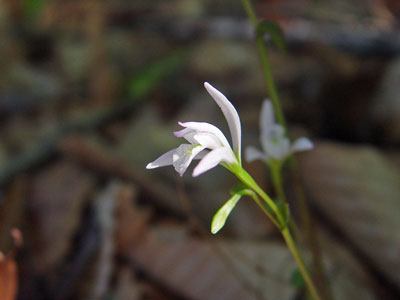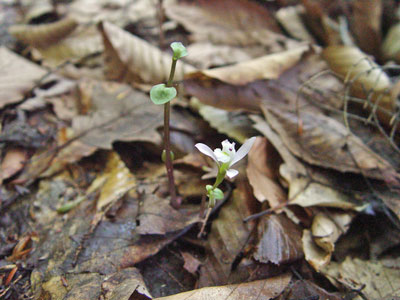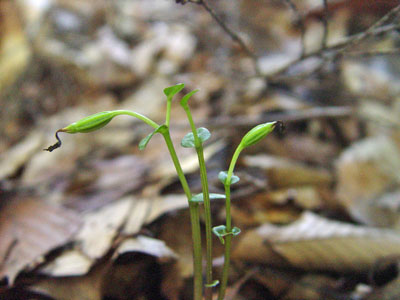DACF Home → Bureaus & Programs → Maine Natural Areas Program → Communities, Plants, and Animals → Rare Plants → Triphora trianthophora

Triphora trianthophora (Sw.) Rydb.
Nodding Pogonia
- State Rank: S2
- Global Rank: G4?
- State Status: Threatened
Habitat: Northern Hardwood (beech-birch-maple) forests, usually dominated by beech, often in deep litter. [Hardwood to mixed forest (forest, upland)]
Range: Southern Maine south to northern Florida and west to Texas and the Lake States; uncommon throughout much of its range.
Aids to Identification: Herbaceous perennial, stem 8-30 cm tall and bearing three (occasionally up to six) pale pink, irregular flowers. The labellum (lip) has three small, longitudinal, green ridges. The stems appear almost leafless, with several small, oval leaves clasping the slender stem.

Ecological characteristics: Nodding pogonia grows in moist hardwood forests. In Maine, it is associated with beech-birch-maple forests, usually where beech is a dominant species. It is frequently found in hillside depressions where mats of hardwood leaves have collected. Because it appears aboveground only sporadically, and flowers briefly before returning underground, the plant is frequently overlooked. Populations may fluctuate from hundreds of stems in one year to no stems in successive years. Another common name for the nodding pogonia, three birds orchid, refers to the (usually) three flowers it bears.

Phenology: Appears above ground in late July, flowers in August and early September.
Family: Orchidaceae
Synonyms: Arethusa trianthophora Sw.; Pogonia trianthophora B.S.P. Also commonly known as Three-birds Orchid.
Known Distribution in Maine: This rare plant has been documented from a total of 10 town(s) in the following county(ies): Aroostook, Cumberland, Kennebec, York.
Reason(s) for rarity: At northern limit of range. The irregular appearance of this plant above ground adds to its appearance of rarity.
Conservation considerations: Typically grows in second-growth beech woods and so appears to tolerate some logging; but effects of logging are not well known, and partial removal of the canopy would be less likely to adversely affect the plant than complete removal. Like almost all orchids, this should not be dug or collected. It is not known to have been successfully propagated, and any plants offered for sale have almost certainly been dug from the wild.
For more information, see the Native Plant Trust's Conservation Plan for Triphora trianthophora.